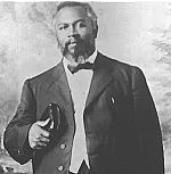The Origins of the Pentecostal Movement
The holiness movement enjoyed the support of the churches until about 1880 when developments disturbing to ecclesiastical leaders began to emerge. Among these was a “come-outer” movement led by radicals who abandoned any prospects of renewing the existing churches. Led by such men as John B. Brooks, author of The Divine Church, and Daniel Warner, founder of the “Evening Light” Church of God in Anderson, Indiana, this movement spelled the beginning of the end of the dream of remaking the churches in a holiness image. At the same time, other radicals began promoting such new teachings as “sinless perfection,” a strict dress code of outward holiness, “marital purity,” and a “third blessing” baptism of fire after the experience of sanctification.
It would not be an overstatement to say that pentecostalism, at least in America, was born in a holiness cradle.

William Seymour
Pentecostal pioneers who had been Methodists included Charles Fox Parham, the formulator of the “initial evidence” theology; William J. Seymour, the pastor of the Azusa Street Mission in Los Angeles who spread the movement to the nations of the world; J.H King of the Pentecostal Holiness Church, who led his denomination into the Pentecostal movement in 1907-08; and Thomas Ball Barratt, the father of European Pentecostalism. All of these men retained most of the Wesleyan teaching on entire sanctification as a part of their theological systems. In essence, their position was that a sanctified “clean heart” was a necessary prerequisite to the baptism in the Holy Spirit as evidenced by speaking in tongues.
Other early Pentecostal pioneers from non-Methodist backgrounds accepted the premise of second blessing holiness prior to becoming pentecostals. For the most part, they were as much immersed in holiness experience and theology as their Methodist brothers. These included C. H. Mason (Baptist), of the Church of God in Christ, A.J Tomlinson (Quaker), of the Church of God (Cleveland, Tennessee), B.H Irwin (Baptist) of the Fire-Baptized Holiness Church, and N.J. Holmes (Presbyterian) of the Tabernacle Pentecostal Church. In the light of the foregoing information, it would not be an overstatement to say that pentecostalism, at least in America, was born in a holiness cradle.
The Origins of Pentecostalism
The first “pentecostals” in the modern sense appeared on the scene in 1901 in the city of Topeka, Kansas in a Bible school conducted by Charles Fox Parham, a holiness teacher and former Methodist pastor. In spite of controversy over the origins and timing of Parham’s emphasis on glossolalia, all historians agree that the movement began during the first days of 1901 just as the world entered the Twentieth Century. The first person to be baptized in the Holy Spirit accompanied by speaking in tongues was Agnes Ozman, one of Parham’s Bible School students, who spoke in tongues on the very first day of the new century, January 1, 1901. According to J. Roswell Flower, the founding Secretary of the Assemblies of God, Ozman’s experience was the “touch felt round the world,” an event which “ made the Pentecostal Movement of the Twentieth Century.”
Category: Church History, Fall 2000


